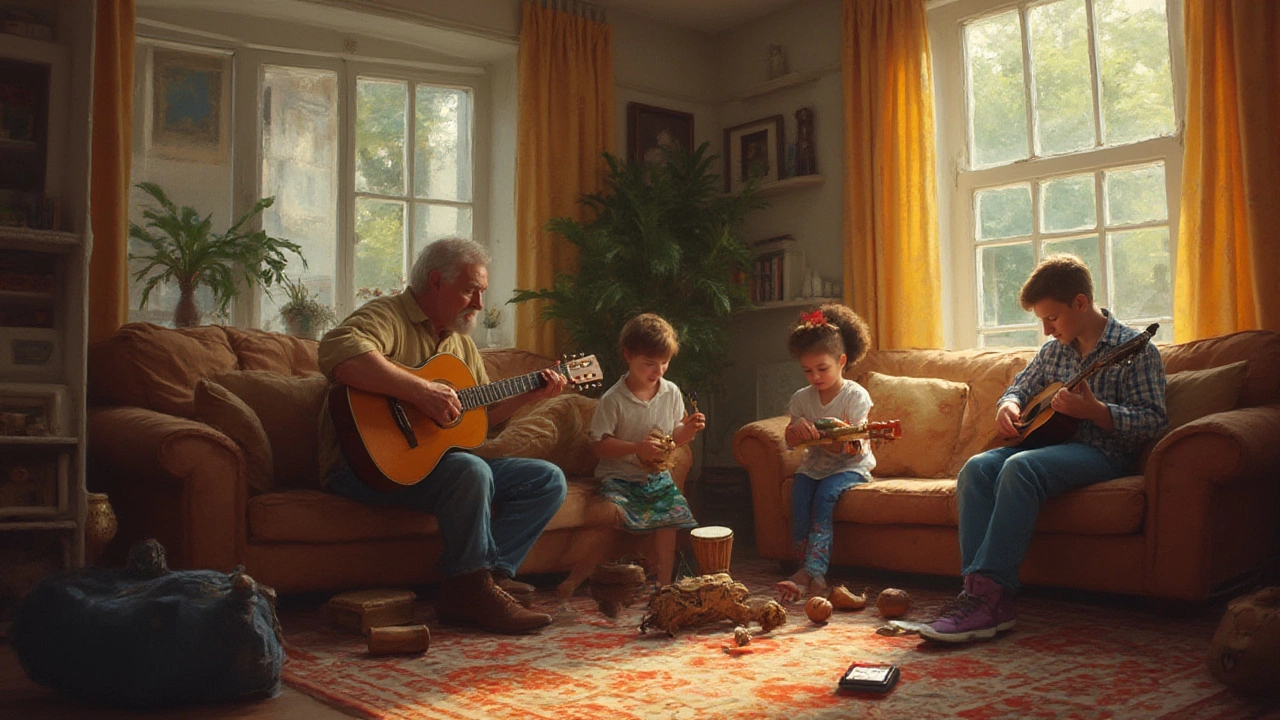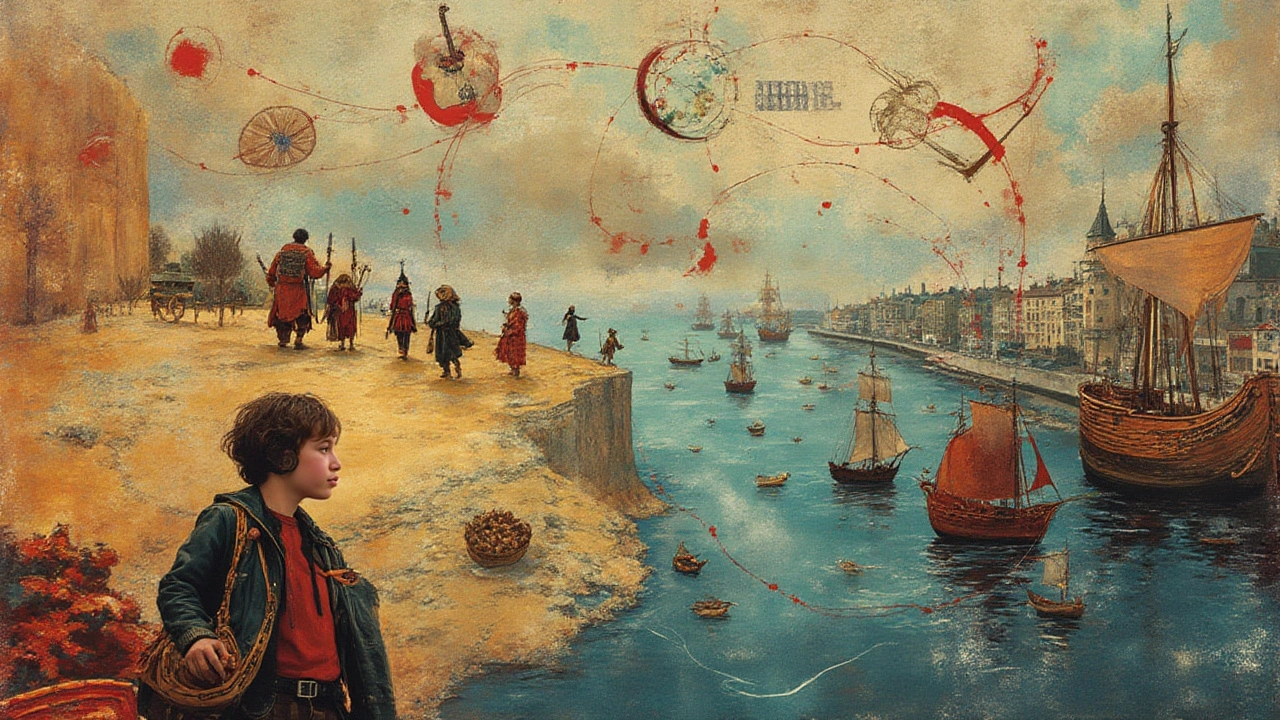Imagine for a moment a world where the flamenco guitar riffs of Spain light up a cold Scandinavian night, or where a Senegalese kora finds its way into a jazz trio in Chicago. That’s not fantasy—it’s happening right now, and it hints at something incredible: musical instruments have become the ultimate passports. They leap across borders on the backs of travelers, migrate with ambitious artists, or just get beamed to billions through viral TikTok snippets. Each time they show up somewhere new, they invite people to listen, to tap their feet, to recognize something familiar in what once seemed foreign. Suddenly, a bamboo flute from a village in Thailand isn’t just a relic—it’s sparking curiosity and inspiring new songs in completely different corners of the world.
The Secret Histories—How Instruments Travel and Transform
Think of the violin. You might picture Mozart or a smoky Parisian jazz bar, but its roots dig all the way back to Central Asia, where horsehair strings and curved wood got their start as tools for storytelling. The Silk Road saw those early fiddles picked up, tweaked, and reimagined across hundreds of cultures, every one shaping them in their own way. When these instruments landed in new places, locals didn’t just copy—they added their own twist: the Indian sarangi, the Chinese erhu, or the Hungarian fiddle all look related, but each one sings with a unique accent.
The djembe drum tells a similar story. It’s a symbol of West Africa, carved out of a single piece of wood and topped with goatskin, but now you’ll hear its rapid-fire rhythms in samba bands from Brazil, street performances in Paris, and meditation retreats in California. The same pattern shows up in wind instruments, too. The pan flute, for instance, appears in ancient Greek myths and Andean folk songs, sitting at the heart of wildly different cultures.
Why do these instruments travel so far? Trade, of course, was the old-school engine—Mozart might never have heard a Turkish cymbal if Ottoman traders hadn’t shown up in Vienna, and Mongolian morin khuur melodies wouldn’t echo in jazz clubs without cultural curiosity. But, it’s not just ancient history. In the 1960s, Western rock bands like the Beatles and the Rolling Stones gobbled up sitar sounds from India, sparking a wave of Eastern-inspired pop music. Today, YouTube stars mash up Chinese guzheng zither with hip-hop beats, and you’re just one Spotify playlist away from a beatboxer looping ocarina melodies from four continents.
Here’s the wild statistic: In a 2023 global streaming analysis, songs featuring “world instruments” were played 252% more often than in 2015. That's not a typo—the appeal of these cross-cultural creations just keeps climbing. If you ever thought musical influences would fade as traditions die out, the data’s showing the opposite. Cultures aren’t walling off their sounds; they’re trading them, remixing them, and feeding them right back into the global mix.
| Instrument | Origin Culture | Year First Spread Abroad | Modern Global Presence |
|---|---|---|---|
| Djembe | West Africa (Mali, Guinea) | Late 1800s (France, Americas) | Bands, wellness classes, schools worldwide |
| Sitar | India | 1960s (UK/US pop music) | Film scores, pop songs, classical fusion |
| Pan Flute | Ancient Greece, Andes | 1900s (Europe, North America) | Global jazz, folk, electronic |
| Steel Drum (Pan) | Trinidad & Tobago | 1950s (Festival circuits) | Tourism, orchestras, electronic loops |
| Violin | Central Asia (early strings) | 1500s (Italy, then Europe) | From classical to bluegrass, Bollywood songs |
Next time you flip on a new playlist, take a second to listen for those borrowed voices. Maybe it's the snap of a tabla under a pop chorus, or the lonesome howl of an Irish tin whistle in a movie soundtrack. Connections like these don’t just make for better music—they’re proof that instruments keep the world talking, even when language falls short.

How Musical Collaborations Break Down Walls
Ever sat in on a late-night jam session and watched strangers connect before they’ve even learned each other’s names? That’s the power of a drum, a trumpet, or a stringed instrument—when words fail, music jumps in and shatters the awkwardness. Every year, global festivals like WOMAD, Glastonbury, and Rainforest World Music Festival give the spotlight to wild, unexpected collaborations: a Japanese koto player swaps licks with a Malian kora master; a beatboxer layers over the low drone of a didgeridoo.
What happens up there on stage isn’t planned or rehearsed by committee. Different playing styles, odd rhythms, even unfamiliar scales—all fuse together in real time. Sometimes, things get chaotic. But the best moments aren’t polished perfection. They’re the split-second improvisations when no one’s quite sure what’ll happen next. Audiences see these musicians figuring it out right in front of them, learning without a roadmap, and ending up somewhere magical.
Think of the instant bonds that form when musicians trade instruments as a kind of friendship shortcut. I’ll give you a real story: at the 2018 Bali Spirit Festival, a blues guitarist from the US hopped onstage with a group of Indonesian gamelan musicians. She’d never touched their complex metal-keyed instruments before, but as they handed her mallets and laughed through her first clumsy notes, the music that followed couldn’t have come from any single tradition. It was a sonic handshake—one that ended with them teaching each other riffs and trading stories over cold drinks after their set.
There’s something about sharing an instrument across cultures that goes deeper than language. Neuroscientists found that when people play music together, their brainwaves start to sync up—literally. It doesn’t matter if one player grew up with folk ballads and the other with Bollywood hits. When they fall into a groove, the science says their minds actually become more open to learning from each other. That's part of why youth exchange programs centered on music see participants reporting more empathy, faster friendships, and even improved language skills compared to non-musical exchanges.
If you’re looking for tips on how to connect with musicians from another culture, bring a little curiosity and leave your ego at the door. Here’s what always helps:
- Learn one traditional song from the other musician’s culture—showing effort matters more than perfection.
- Let go of the idea of “right” and “wrong” notes; embrace unfamiliar rhythms or scale patterns.
- Swap stories about how you learned your instrument—shared challenges create instant rapport.
- Don’t underestimate nonverbal cues. Pay attention to body language, facial expressions, and musical gestures.
- Always ask before handling someone’s instrument. Many cultures treat certain pieces as sacred or highly personal.
Even if you’re just a listener, try asking musicians about their instruments’ backstories. It’s amazing how many times an artist will share memories of a family member, a festival, or a life-changing journey. These conversations open doors wider than you’d ever expect. There’s a reason jam sessions and instrument trades pop up in every corner of the world: deep down, everyone loves a good story, especially when it comes wrapped in music.

Boosting Cross-Cultural Connection: What You Can Do
Music doesn’t need gatekeepers. You don’t have to be an expert to dive into another culture’s rhythms, chords, or melodies. You just need curiosity and the willingness to listen. You’d be amazed by the resources and communities now available, making it easier to explore and share music traditions from around the world.
Start by checking out cross-cultural music platforms. There’s Radio Garden, where you can literally spin the globe and tune in to radio stations from Mozambique to Mongolia. Social media groups focused on instruments—like Facebook’s ‘World Flute Society’ or Reddit’s ‘Ethnomusicology’—bring together thousands of enthusiasts swapping tips, songs, and instrument DIY hacks, all in real time. Even streaming services have curated lists: search for ‘Global Fusion,’ ‘Latin meets Jazz,’ or ‘Afro-Asian Beats,’ and you’ll find collaborations you never dreamed existed.
For anyone interested in playing a new instrument, online tutorials have become a goldmine. YouTube channels like Rob Scallon’s or Linsey Pollak’s break things down so anyone (yes, even those with no musical background) can get their hands on an Irish tin whistle, a Turkish bağlama, or a Chinese hulusi and pick up a song by day’s end. If you’re more of a hands-on learner, many community centers and language schools offer instrument workshops led by musicians from around the world. Don’t be afraid to show up solo—the vibe is always welcoming, and you’ll likely meet fellow music geeks who are just as pumped to try something new.
Travel is another game-changer, but you don’t need a huge budget. Look for local cultural festivals in your city, where you’ll find performances, instrument demos, and even hands-on jam sessions. If you're lucky, a master musician might explain the hidden stories behind their instrument—like how the South African mbira was once banned by colonists because it was considered “too powerful,” or how the Armenian duduk survived centuries of political turmoil to become a sound of hope in film scores and pop music alike.
Don’t forget the classroom. Schools that add musical instruments from multiple cultures into their programs consistently report better student engagement and smoother social integration, especially in diverse or immigrant-heavy communities. According to UNESCO, children exposed to world music instruments are nearly 60% more likely to develop curiosity about other cultures. So, if you're a parent or teacher, consider adding a few djembe drums, djembes, or even a set of taiko to your next music lesson. Even listening projects—like picking a new country’s instrument every month—can spark lifelong learning.
And here’s a reality check—sometimes trying a new instrument will feel weird, and your first sounds may be nothing like the pros. That’s normal. Every master kora player, tabla whiz, or bassoon star started with awkward plucks and honks. But instruments aren’t just about playing a perfect tune—they’re about discovery and connection. Every missed note is one step closer to understanding someone else’s story.
If you just want to enjoy the ride, attend a concert, stream a new playlist, or start a conversation with a musician whose gear looks unfamiliar. Ask them why they chose that instrument and what memories it stirs up. You might discover how the musical instruments you thought belonged to others actually bridge cultures you carry inside you.

